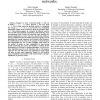492 search results - page 13 / 99 » The number of possibilities for random dating |
JSAC
2008
13 years 8 months ago
2008
Suppose we have a directed graph G with set of nodes V = {1, . . . , N} and a measure xi for every node i V . The average consensus problem consists in computing the average xA = ...
SOFSEM
2012
Springer
12 years 4 months ago
2012
Springer
The classical group testing problem asks to determine at most d defective elements in a set of n elements, by queries to subsets that return Yes if the subset contains some defecti...
DATE
2005
IEEE
14 years 2 months ago
2005
IEEE
As the scale of electronic devices shrinks, “electronic textiles” (e-textiles) will make possible a wide variety of novel applications which are currently unfeasible. Due to t...
DATE
2003
IEEE
14 years 1 months ago
2003
IEEE
Test pattern decompression techniques are bounded with the algorithm of test pattern ordering and test data flow controlling. Some of the methods could have more sophisticated sor...
PADL
2010
Springer
14 years 5 months ago
2010
Springer
Explanations are a technique for reasoning about constraint propagation, which have been applied in many learning, backjumping and user-interaction algorithms for constraint progra...

